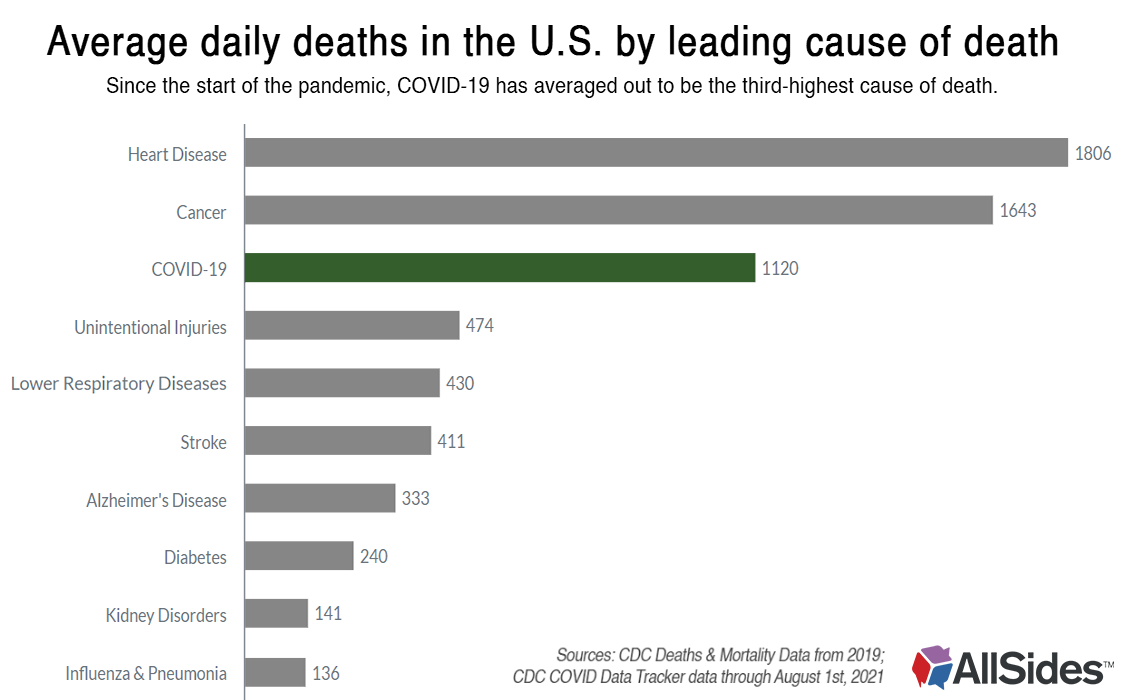How COVID-19 Compares to Other Leading Causes of Death

COVID-19 has become a constant in the news cycle, but with so many competing narratives and sensationalism on both sides, it can be hard to get an understanding of where the numbers lie and what the risks are for different groups. Here is a breakdown of where things stand.
As of August 20th, 2021, the CDC reports that over 623,000 deaths have been attributed to COVID-19 in the United States since February of 2020 – a span of 18 months. That number averages out to about 1,120 deaths per day, and adds up to about 0.2% of the total U.S. population.
According to 2019 CDC data, this would put COVID-19 as the third leading cause of death in the U.S. behind heart disease and cancer, which caused a combined 1.2 million U.S. deaths in 2019.

The CDC established that if COVID-19 is listed as an “underlying cause” or a “significant condition contributing to death” on a death certificate, it is counted in CDC mortality statistics.
For example, a person’s immediate cause of death may be a respiratory condition that arose from COVID-19. In this scenario, COVID-19 would be listed as an “underlying cause” since it caused the condition which led to death. The CDC describes in COVID-19 reporting guidance that underlying causes are “diseases or injury that initiated the events resulting in death.”
Contributing conditions are just that: they contribute to the death of an individual but are not the underlying cause. An example of this is often someone with heart disease – COVID-19 must be a “significant condition contributing to death” in order to classify as a death related to COVID-19.
What does this mean for COVID-19 death totals? They’re merely estimates. In some cases, such as the beginning of the pandemic, the death toll may have been undercounted before official reporting guidelines were put in place, or if a COVID-19 diagnosis is not confirmed in a deceased individual. Likewise, it may be difficult for health professionals to determine how COVID-19 played a role in someone’s death, especially if an autopsy is not performed.
Physicians who fill out the death certificates will have the final say as to if they believe that COVID-19 was a factor in the death of an individual. If not, it is left off altogether.
As of August 20th, 2021, the case-fatality ratio of COVID-19 is 1.7%. In other words, about 1.7% of COVID-19 cases have resulted in death from COVID-19, according to Johns Hopkins’ Coronavirus Resource Center. That number varies by age group, however, as nearly 80% of deaths in the U.S. are of people aged 65 or older, and somewhere between 40-50% of deaths are of people over the life expectancy of about 78 years.
Underlying conditions are attributed to most deaths (76%, based on a CDC report). The same report indicates that as many as 40% of U.S. adults who’ve died from COVID-19 were also suffering from diabetes, even if it wasn’t listed on the death certificate.

One analysis shows that nearly 40% of U.S. adults – over 90 million people – fit into higher risk categories (that is, are over 65 years of age and/or have a medical condition). The exact number of people with underlying conditions is unknown.
Almost two-thirds of all COVID-19 deaths also list heart diseases or conditions such as hypertension disease. On average, there are about four additional conditions associated with deaths when COVID-19 is listed on a death certificate.
The number is also partly due to manifestations of other conditions such as respiratory failure or heart attacks, which may be caused by COVID-19.
About 20% of people under the age of 65 are at higher risk. In other words, they have conditions such as those listed in the chart above. Nearly 3% of U.S. adults under the age of 65 use immunosuppressive drugs, making them especially vulnerable to severe COVID-19 infection.
Racial and ethnic minorities are also disproportionately affected by COVID-19. Risk for death, when compared to non-hispanic White people, is 2.4x higher for American Indians, 2.3x higher for Hispanic/Latinos, and 2.0x higher for Black people.
The onset of COVID-19 in 2020 led to the largest yearly decline in U.S. life expectancy since World War II, according to a CDC release. COVID-19 reportedly accounted for 11% of the over three million U.S. deaths in 2020.
This is one thing that sets COVID-19 apart from the other top leading causes of death: extreme volatility. In January, the U.S. averaged 3,277 deaths per day due to COVID-19 – over 100,000 deaths in the month. In June, the average was 289 deaths per day, a 91% decrease from five months earlier.
In comparison, deaths from cancer had an average of 1,675 deaths per day in the U.S. in 2020, according to CDC data analyzed by AllSides. The lowest weekly average of cancer deaths was 1,558, just a 9.7% decrease from its highest 2020 weekly average of 1,709.

The chart above shows that COVID-19 was the leading cause of death in the U.S. throughout the entire month of January 2021, as well as parts of February and last December.
In June, deaths from COVID-19 were fewer than deaths from stroke, respiratory diseases, and unintentional injuries (accidents) – less than 300 on average per day.
Once the vaccine became widely available in the U.S., the number of COVID-19 deaths plummeted down to 8,285 in July of 2021, its lowest levels since the very beginning of the pandemic. As of July, over 98.5% of COVID-19 deaths have occurred among unvaccinated or not fully vaccinated people. This data, however, was collected before cases started rising in the U.S. due to the prevalence of the Delta variant of COVID-19; additional research is required to show how effective the vaccine is in the long-run at preventing COVID-19 deaths, as recent studies have shown a decline in effectiveness of vaccines.
Many on the left argue that because of how unpredictable COVID-19 is, especially in the rise of the Delta variant, precautions such as mask and vaccine mandates should be implemented. On the right, many point to the low level of deaths associated with contracting COVID-19, and argue mask and vaccine mandates violate bodily autonomy and civil liberties.
Andrew Weinzierl is AllSides’ Research Assistant and Data Journalist. He has a Lean Left bias.
This piece was reviewed by Managing Editor Henry A. Brechter (Center bias) and Director of Marketing Julie Mastrine (Lean Right bias).

April 22nd, 2024

April 19th, 2024

April 19th, 2024

April 18th, 2024